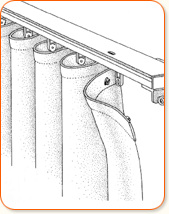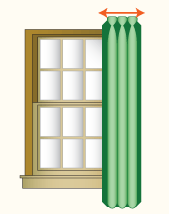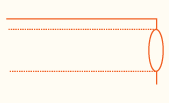Making Your Curtain Rod or Traverse Rod Stronger
If you need to hang long or heavy drapes, you can increase the strength of your curtain rod or traverse rod by ordering a telescoping rod with a minimum width near your window size.
For instance, for a 48" window, order a telescoping rod that fits a 48" to 84" window and you'll double-up the rod thickness making for a studier rod.
Consider Your Drapery Type, Weight And Stack Back Before Choosing Your Kirsch Drapery Hardware
You don't want to buy a Curtain Rod or Traverse Rod only to discover that your drapery won't work with the rod you ordered. Traverse Rods are typically made for Pinch Pleat style draperies while Curtain Rods are made for sheers, valances or light weight stationary panels.
What To Do If Your Traverse Drapery Isn't Pinch Pleat

Pinch Pleat draperies are by far the most common drapery found in residential settings. However, some homeowners have opted to install Ripplefold draperies in their homes.
Ripplefold draperies use snaps instead of hooks and the spacing of the snaps cause the drapery to fold when closed, giving the flat panel a rippled look. The spacing of the snaps determines how "full" the drapery looks. The closer the snaps are to each other, the greater the drapery "fullness".
If you are having Ripplefold draperies made for your home, then you'll need to have a Kirsch Ripplefold curtain rod custom made for your draperies. Your drapery maker will have to tell your rod maker the "fullness" so the appropriate snaps can be installed into your rod.
A conventional traverse rod will not work with Ripplefold draperies.
Calculating Drapery Stack Back For Traverse Curtain Rods

Stack Back is the amount of open space needed if you want your drapery to clear your window completely when your draperies are open. This is sometimes called "Stack Off The Window".
To make sure your draperies clear your window opening, you should add the Stack Back width to the width of your window opening before you order your rod.
| Window Opening | Stack Back | Rod Length |
| 24" | 21" | 45" |
| 30" | 23" | 53" |
| 36" | 25" | 61" |
| 42" | 26" | 68" |
| 48" | 29" | 77" |
| 54" | 30" | 84" |
| 60" | 31" | 91" |
| 66" | 32" | 98" |
| 72" | 34" | 106" |
| 78" | 36" | 114" |
| 84" | 37" | 121" |
| 90" | 38" | 128" |
| 96" | 39" | 135" |
| 102" | 42" | 144" |
| 108" | 44" | 152" |
| 114" | 45" | 159" |
| 120" | 48" | 168" |
Carrying Capacity For Traverse Kirsch Curtain Rods
You should always take into consideration the weight of your draperies when choosing a Traverse Curtain Rod. Conventional Curtain Rods can typically carry a medium weight face fabric with a standard lining. For heavier face fabrics (like Velvet), or draperies that are heavily lined and interlined, you may need to have a Traverse Rod custom made.
Kirsch drapery hardware can typically carry about 1 pound per foot if they're a split draw rod or about 0.8 pounds per foot as a one-way draw rod.
One-way draw rods can carry a maximum fabric weight of about 15 pounds, while split draw rods can carry a maximum fabric weight of about 20 pounds.
Drapery Or Valance Rod Pocket Depth For Curtain Rods

Most valances, top treatments and sheers install on a curtain rod using a rod pocket. Match your drapery to the appropriate Curtain Rod by measuring the size of the rod pocket.
| Rod Style | Rod Depth | Pocket Depth |
| Sash | 1/4" - 3/4" | 1" - 1 1/2" |
| Lockseam Curtain | 3/4" | 1 1/2" |
| Continental I | 4 1/2" | 5 1/2" |
| Continental II | 2 1/2" | 3" |
You should select your drapery hardware after you decide what type of curtain you want to hang. You want to make sure that the Kirsch curtain rods you buy will work for your drapery style. Before you being choosing your drapery hardware find out if your curtains are pinch-pleat or ripplefold or if you're using a tab-top or rod-pocket style drapery or valance. Once you determine your drapery style, it'll be a lot easier to choose the correct curtain rod.
©2024, Designer Drapery Hardware, LLC


